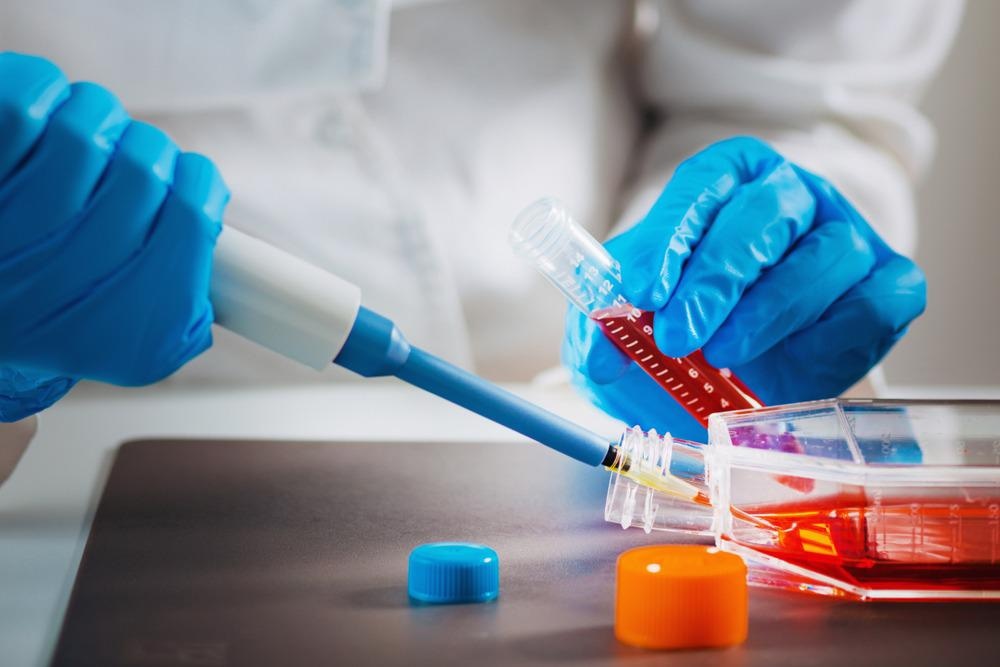Chinese scientists have reported the development of a novel scaffold material for use in tissue engineering applications. The results of their research have been published in the journal ACS Applied Polymer Materials.

Study: Microporous Spongy Scaffolds Based on Biodegradable Elastic Polyurethanes for the Migration and Growth of Host Cells. Image Credit: Microgen/Shutterstock.com
The Importance of Optimal Tissue Scaffold Design
The design of scaffolds and the materials employed in their fabrication are critical factors in the success of tissue engineering procedures. Optimizing scaffolds improves the migration, proliferation, differentiation, and growth of cells used to regenerate damaged and defective tissues. Scaffolds must contain appropriate porosity characteristics.
Microporous scaffolds facilitate the production of M2 inflammatory cells from transformed M1 inflammatory cells. This is vital during the healing process as M2 cell types contribute to rapid and effective tissue regeneration. Pore size also governs the type of tissue that can be grown within scaffolds, with scaffold with smaller pores facilitating the growth of endothelial cells, whilst smooth muscle cells grow in larger-pored scaffolds.
Microporous scaffolds have several other benefits for tissue engineering and regenerative medicine. For instance, they absorb and retain nutrients from the extracellular environment, enhance host cell viability, and help to metabolize waste products.
Several properties of three-dimensional scaffolds affect their suitability for tissue engineering applications and performance, including their biocompatibility, surface wettability, mechanical properties, and mechanical compatibility with native tissues. Optimizing their material parameters has a significant impact on the success of tissue scaffolds for tissue regeneration.
Scaffolding Materials
Aside from the structure of 3D scaffolds, the chemical and physical properties of biomaterials used in their construction are vital factors that govern the success of tissue engineering procedures. Several natural and synthetic polymers and polysaccharides have been explored for use as scaffold materials. Natural biopolymers, for instance, have better biocompatibility than their synthetic counterparts.
More from AZoM: What is Freeze-Fracture Electron Microscopy?
Natural polysaccharides, for instance, have abundant surface amino groups and possess better adhesion capabilities due to the presence of positive charges. However, synthetic polymers can possess better mechanical properties than their natural counterparts. Ideal tissue scaffold materials must possess both superior biocompatibility and mechanical performance.
Biodegradable Polyurethane Scaffolds
Biodegradable polyurethanes are a class of biomaterials that have found increasing application in the field of tissue engineering as scaffold materials. These materials possess outstanding properties such as biocompatibility, controllable biodegradability, and adjustable mechanical properties. Several methods have been applied to produce these scaffold materials, such as electrospinning and thermally induced phase separation.
Thermally-induced phase separation has shown particular promise as a preparation technique, due to thermodynamic incompatibility of the soft and hard elements in the materials and the induction of microphase separation. Biodegradable polyurethane scaffolds have a film-like microphase surface structure, and the presence of different surface free energy distributions improves the material’s adsorption capacity. Moreover, the material can inhibit platelet adhesion, reducing the danger of thrombosis.
Several studies have concentrated on these materials in recent years, including mechanical characterization studies that have demonstrated remarkable compressive and tensile properties, synthesizing self-healing materials with tunable mechanical properties, and histological analyses that have demonstrated the material’s outstanding tissue repair abilities. However, many studies have concentrated on tuning mechanical properties and have not investigated molecular-level modifications to improve the biocompatibility of scaffolds.
The Study: A Novel Approach to Improving these Biomaterials
The authors behind the research have reported the two-step synthesis of a novel scaffold biomaterial for use in tissue engineering. The research aims to improve upon the biocompatibility of conventional biodegradable polyurethanes.
The physical and chemical properties of biodegradable PEEUUs were modified by the inclusion of polyethylene glycol into their soft structures in different concentrations. Additionally, polycaprolactone was incorporated into the biodegradable biopolymers. Then, using thermally induced phase separation, a 3D microporous spongy scaffold was prepared from the modified biodegradable polyurethanes.
The synthesized scaffold possessed more bioactive sites, improving the adhesion, growth, and proliferation of engineered cells and thereby enhancing the regeneration rate of tissues. The morphology and microstructure of the prepared scaffold materials were analyzed and categorized by the authors, along with important properties such as wettability, porosity, and degradation rate as well as mechanical performance. Furthermore, a cytocompatibility analysis was performed.
The authors discovered that altering the synthesis formula regulates the scaffold’s porosity and hydrophilicity. Adding polyethylene glycol to the material increased the scaffold’s degradation rate and hydrophilicity. The prepared scaffolds displayed a highly interconnected pore structure. Superior recoverability was observed, along with controllable mechanical matching. Moreover, the outstanding biocompatibility of these novel materials was confirmed by in vitro experiments.
In summary, the authors have reported the development of a novel class of biomaterials that improve upon the biocompatibility issues with biodegradable polyurethanes, providing a promising route for synthesizing microporous spongy tissue scaffolds. Additionally, the authors have stated that these scaffold materials are suitable for assorted sizes of cell growth. The scaffolds presented in the research are an interesting research direction for the field of tissue engineering.
Further Reading
Huang, K et al. (2022) Microporous Spongy Scaffolds Based on Biodegradable Elastic Polyurethanes for the Migration and Growth of Host Cells ACS Applied Polymer Materials |pubs.acs.org. Available at: https://pubs.acs.org/doi/10.1021/acsapm.2c00398
Disclaimer: The views expressed here are those of the author expressed in their private capacity and do not necessarily represent the views of AZoM.com Limited T/A AZoNetwork the owner and operator of this website. This disclaimer forms part of the Terms and conditions of use of this website.